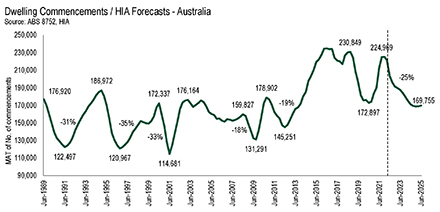Demand for new detached and multi-unit housing has remained strong, suggesting that the current boom in home building will be sustained throughout 2022. HIA released its economic and industry Outlook Report for Australia yesterday. Source: Timberbiz
The Outlook Report includes updated forecasts for new home building and renovations activity for Australia and each of the eight states and territories.
“Demand for new detached home construction has remained strong because of economic lockdowns,” HIA Chief Economist Tim Reardon said.
“There has been a clear shift towards lower density housing during the pandemic and this trend does not appear to show signs of slowing,” he said.
“This shift is not just those in units moving to detached housing but includes a shift to fewer people per household.
“As a result, we have seen a significant change in the volume, type and location of new homes. These trends are similar in other countries.”
Mr Reardon said that leading indicators of demand showed that the demand for new detached homes remained strong.
Sales since the end of HomeBuilder (April 2021 – October 2021) are the strongest they have been since 2017 when over 115,000 detached homes commenced construction.
“This strong level of home building activity suggests that the current boom in residential construction will be sustained throughout 2022,” Mr Reardon said.
“The full impact of the loss of migration is yet to fully impact demand for detached housing and a rise in interest rates will mark the end of this COVID building boom.”
The shift to lower density was also the likely driver of recent demand for multi-units.
Approvals for multi-units were 34.3% higher in the September 2021 quarter than the same quarter a year earlier.
Mr Reardon said this was being driven by both medium density housing and high-rise apartments.
“Investors are looking through the haze of the pandemic to a brighter outlook on the other side,” he said.
“Affordability constraints are also pushing households, particularly first home buyers, back to townhouses and apartments.
“The industry will continue to run at capacity throughout 2022, constrained by the availability of land, labour and materials.”
Over the year to September, the price of skilled trades increased by 5.2%, while the price of materials as measured by the ABS increased by 8.0%. The price of residential land increased by 8.5% in the 2020/21 financial year. This has led to an increase in the cost of a new house and land package.
“These cost increases have not led to constraints on access to finance, as the cost of an established home has increased significantly faster,” Mr Reardon said.
“In this outlook, we have reviewed our medium-term forecasts. The COVID pandemic has had a material impact on key drivers for housing demand including density, location and type of housing,” he said.
“It is anticipated that the COVID pandemic will see fewer homes built in Sydney and Melbourne over the decade than was previously forecast. All other regions benefit from this shift in location of housing.”








